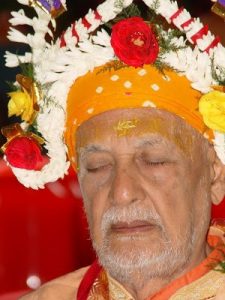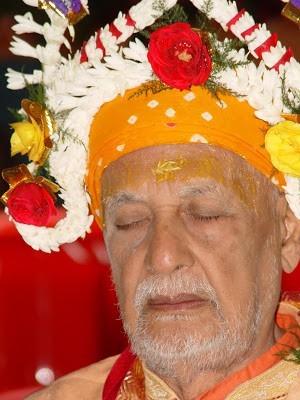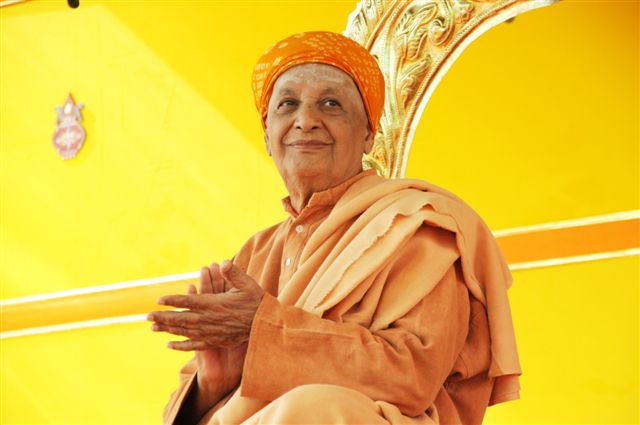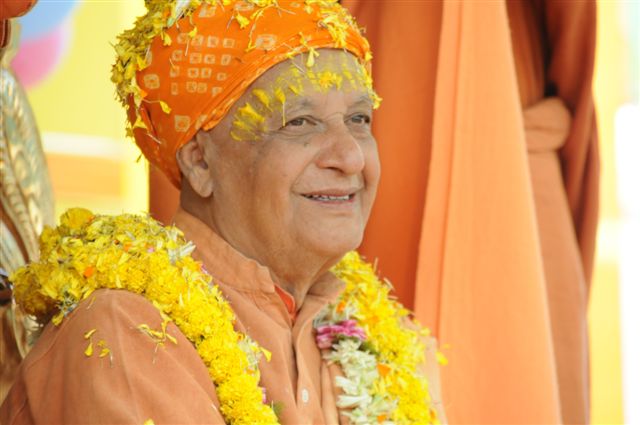 Satsang by Swami Satyananda
Satsang by Swami Satyananda
Spiritual clarification is what people throughout the world want today. When everything has been said, the last words remain, ‘What to do?’ We have to plunge ourselves into the art and act of meditation. In yoga, meditation is known as dhyana yoga; this is the technical word used in the yoga scriptures. The English word meditation does not convey the whole import, so we’ll first explain the meaning of dhyana yoga.
In Patanjali’s Yoga Sutras, meditation is defined as ‘when the mind has been able to transcend the knowledge of smell, sound, touch, form and taste, and at the same time, when the consciousness is functioning around one point’. This is the technical, classical definition of dhyana. It is not the act of concentration, when we are trying to concentrate or consolidate the dissipated energies of our mind. That is not dhyana, but the way to dhyana. What we have been doing in yoga classes is not dhyana.
There are three distinct stages in this practice. The first leads to sense withdrawal, the second to concentration, and the last to meditation, dhyana. It is not the mind that we have to tackle first, it is the sensations, the knowledge of the five senses. If you close your eyes, you are only blocking the sensation of form. What about the ears? You can still listen to so many sounds. To give a clear example, if you imagine a little point, and try to concentrate on it, what happens? The senses continue to feed the mind throughout. The messages keep coming to the brain, which therefore, remains in an excited condition. In the practice of dhyana yoga the first thing you have to do is cut the supply routes, which carry sensations to the brain constantly, during wakefulness, sleep, and dreams. That is the first stage in dhyana yoga.
In the second stage you have to concentrate on one point. The point can be anything- a cross, your guru, a black dog, a flower, a light, a star. What is important is that the object of meditation, which you have selected, is an absolutely spontaneous choice of your mind, so that you don’t have to force it. For instance, I find it easy to concentrate on the form of my guru, because I lived with him for twelve years. It is difficult for me to concentrate on a form which I have not seen. It is not the divinity of the object, which is important when you are trying to concentrate. It is your fraternity with the object that is important – how close you feel, how spontaneous you are, how comprehensive and intimate your relationship is with that object. If you do not feel these things then you will find concentration very hard. Again and again your mind will become dissipated. I will give you a parable.
Once upon a time a young girl was going to meet her boyfriend. She was deeply engrossed in remembering him. In the lane through which she was passing, a Muslim had spread his mat and was repeating his prayers. Muslims pray five times a day, anywhere and everywhere, even in the middle of the road. They are very strict about their prayer time. So he had spread his mat and was saying his prayers, ‘Allah, Allah, Allah’. The girl was so much engrossed in thoughts of her lover that she walked right over his mat, and kept going. The man who was praying looked at her and said, ‘Arrogant, shameless, uncivilised!’ Then, unable to control himself, he got up from his mat and called after her. The girl continued walking and did not respond. He became furious and followed her, calling ‘Hey’, and again she did not respond. Then he ran ahead of her, blocked her way, and shouted, ‘Why did you walk over my mat?’ The girl was taken aback and asked, ‘What mat? What do you mean?’ The man said, ‘I was praying, and you walked over my mat, you unholy wretch!’ The lady paused for a moment, and then gave a very revealing reply, ‘I was so engrossed in thoughts of my lover that I did not see you or your mat. How could you have seen me walk over your mat if you were praying to God?’
The object, which you select for concentration, should be like the beloved of the girl, not the beloved of the man. That’s where most of us have been making a great mistake. All of the saints, from the vedic rishis to Buddha, Christ, Mohammed, right down to the present day, have all been hitting on the same note- bhakti yoga. Your object of concentration should be related to you through your heart, not through your intellect. The mantra, which is an object for spiritual concentration, and the deity, which is also the basis for consolidation of dissipated energy, should be a matter of heart more than head. What is heart? It is spontaneity of feeling, selection and choice. When you want to get out of the mental plane you have to use a greater force. A little bit of practice with a dry mantra here and a dry deity there will not do. One of the great saints of Indiawas Mira Bai. She was a princess and a queen, and then she became a swami, a sannyasin. She left her kingdom and devoted her whole life to the spiritual quest until she reached the final destination. Every Indian knows her songs. Mira Bai says that when there is infinite love there is no further practice – my beloved is in me, and therefore I don’t have to go out anywhere.
This spontaneity of devotion, this bhakti yoga, is the culminating point, which everyone should remember. When one wants to evolve in spiritual life, dry raja yoga will not do. Full, exciting kundalini yoga will not do. I have absolute respect for all of these, because I teach them. I am not criticising them, I am only pointing to their limitations. You have to awaken the devotional aspect in yourself – and don’t say that you don’t have it. If you did not have this stuff in you, how could you hate and how could you love? How could you cry and how could you laugh? Emotion, passion, attachment, the knowledge and feeling of pleasure and pain are based on, or are the offspring of this stuff called bhava – attitude, bhakti, and devotion. This is a very important thing that we now have to ponder in our lives. We have been living the life of a Christian, devoted to Christ, God and the church. We have been living the life of a Hindu, devoted to Hindu dharma, the temple, Rama and Krishna etc. In the course of time all of these religious formalities have followed a tradition of decadence. There is nothing wrong in them, but everything has degenerated and decayed, and our gurus, in Hinduism as well as in Christianity, have failed to explain how bhakti or devotion is intimately connected with the emotions and passions of our lives. Just as a passionate man loves a woman, so we must approach our deity with the same force, the same urge, the same attitude and the same spontaneity. Do you have to make any effort when you love somebody? No. It’s not difficult. Maybe sometimes you have to control yourself!
There is a technique by which bhakti will become spontaneous. There is a method, by which this dormant devotion will become a reality in your life. Ramakrishna Paramahamsa was once encountered by a disciple when they were travelling in a small boat. ‘Paramhamsaji’, he said, ‘please tell me how to feel the spontaneity of love for God’. Ramakrishna became angry. ‘What nonsense you are speaking’, he said, and threw him into the river telling the boatman to row on. The disciple couldn’t swim and he was gasping, struggling, pining for life. The boatman rescued him. After some time Ramakrishna said, ‘How did you find the experience?’ The disciple said, ‘There was only one thing in my mind – how to survive’. It is this one pointedness that is required when we sit for meditation. There should be nothing in our minds but our guru, nothing but our faithful deity. But it’s not there. Why? Because we have been practicing dhyana yoga without developing our love to the full extent. This bhakti aspect of our lives has been misled. We have been squandering it. Where has our bhakti gone? To the pictures and television, from one man to another, from one girl to another, from one type of dress to another. We have been squandering this great priceless gem of eternal reality, which every being possesses. Everybody has bhakti, and this has to be developed. Therefore, the one who ignites the dormant bhakti in your personality, the guru, comes first in the spiritual life. Once bhakti is developed, dhyana yoga becomes spontaneous. You close your eyes and things start happening.
For awakening bhakti, guru is first, kirtan second and satsang third. Satsang is association, congregation, conference, meeting with people to discuss things pertaining to spiritual life- not politics, sociology, finances, romance, weather, clothes, or food, but spiritual life. Sat means ‘positive, reality, spiritual’. Sang means ‘coming together’. Satsang is very important.
Finally, someone must tell us the stories of those great saints who had the vision of supreme reality. Longfellow, the great poet, said that we have to read the lives of the great saints to make our own lives sublime. Usually, if we read anything about them at all, a Hindu only reads about the Hindu saints, and a Christian about the Christian saints. But perhaps they were neither Christian nor Hindu. Throughout history these saints have led a unique type of life. They have experimented with a new system of life, a new conduct, a new way of thinking. They were the revolutionaries of their time. I have read practically all of them; the Hindu, Christian, Sufi, Muslim, Hebrew and Greek saints. If you go through their lives, they will inspire you. Their inspiration will awaken the bhakti. This is how we have to plod on with our spiritual consciousness.
It is also very important that a systematic practice be followed at home. Those of you who are practicing should continue. Those who are new must remember that what we have done so far with our lives has not paid any dividend. We have been groping in darkness, and it is time we opened ourselves to a new type of life, which does not hinder the external life, but which opens the beatitude of the inner life.
Ramakrishna Paramahamsa used to say to his disciples, ‘Look here. Food is necessary for the body, and so is sleep, because that is the dharma, that is the urge of the physical body. But you have neglected the needs of the spiritual body!’ By dedicating yourself to the spiritual purpose, and by pursuing this path with the utmost sincerity and diligence, you will be the richest person on earth. Of what avail are material riches if they cannot give you peace of mind, tranquillity, mental balance and understanding of your own self? Even if you are an ordinary person with just a few dollars in your pocket, if you have equilibrium, understanding of yourself, and confidence in what you exist for, then you are not only the richest person, you are the president of all nations. You have seen in history that an ordinary person like Christ could become king of kings. What was Ramakrishna? An ordinary priest. What was Saint Francis? All the saints and sages have realised that the real riches, the real prosperity, and the real wealth, lies within one’s own self. Therefore, side by side with the outer life you have been leading so far, you must diligently pursue and follow the inner path of dhyana yoga.




